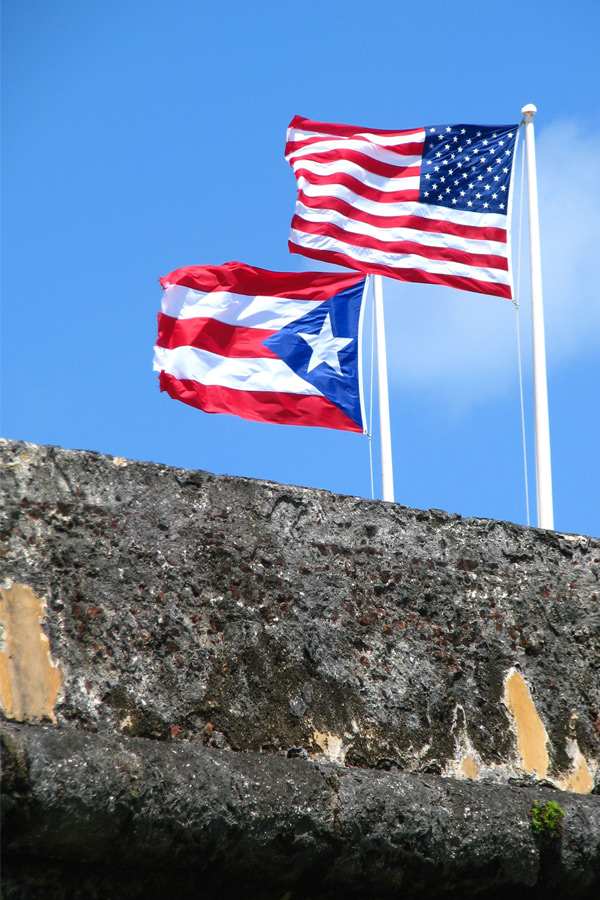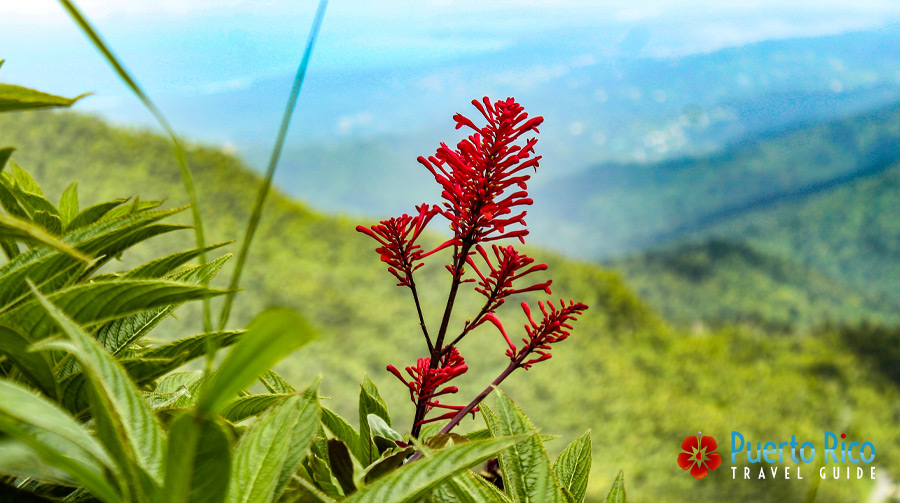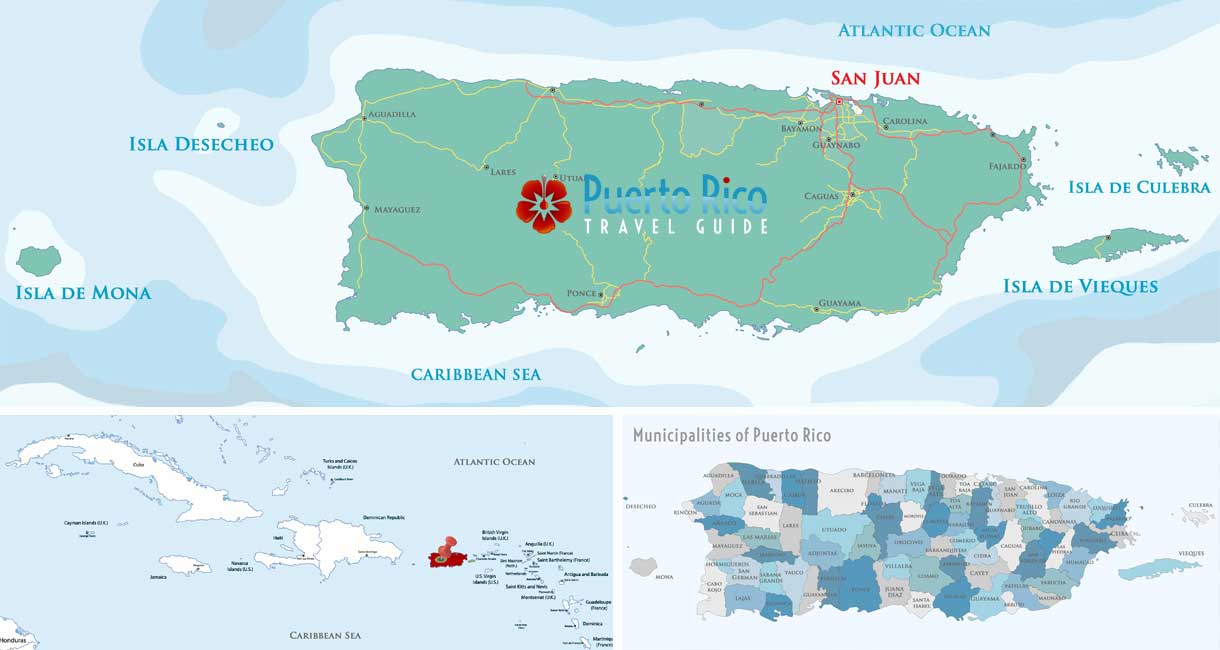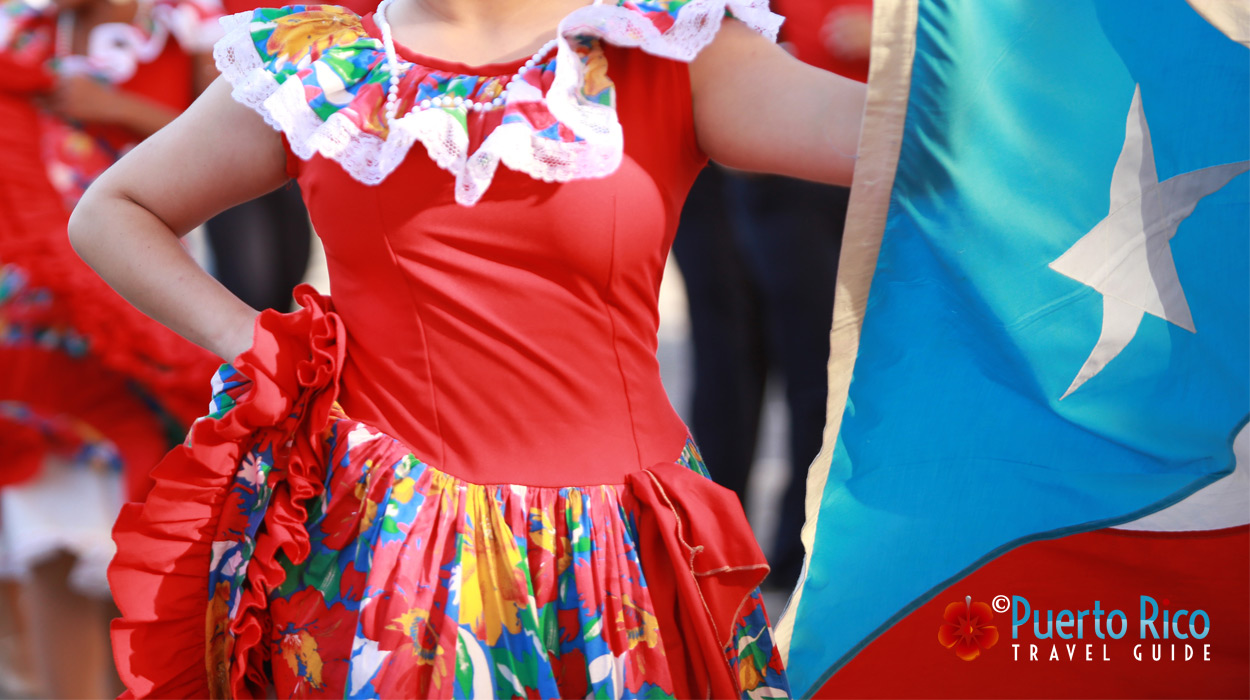🇵🇷 Puerto Rico ⎮ About Puerto Rico & Facts

No passport is required for U.S. citizens to enter Puerto Rico. The official name of Puerto Rico is Estado Libre Asociado de Puerto Rico (Free Commonwealth of the United States), an unincorporated territory of the United States since 1952, those born on the island are U.S. citizens.
English and Spanish are both “official” languages of Puerto Rico, and most staff in tourist regions are bilingual. You’ll see the American influences in everyday life around the island, while still maintaining its own culture, language, and traditions.

Puerto Ricans are known to be among the happiest people in the world. Their festive outlook on life inspires visitors and is evident in their hospitality, making your stay and excursions extra special. Forget your busy life while in Puerto Rico and get immersed in the vibrant culture and richness of Puerto Rican Island Life.
Where is Puerto Rico & Basic Facts

Puerto Rico, an island in the Greater Antilles of the Caribbean is 35 miles wide (north – south), and 100 miles long (west – east), just under the size of Connecticut; it is the largest island of Puerto Rico’s archipelago. San Juan, is the capital city of Puerto Rico. West of Puerto Rico is the neighboring country of the Dominican Republic, the point of Rincon is directly across from Punta Cana. Puerto Rico has 78 municipalities, including the islands of Culebra and Vieques.
Puerto Rico is a Caribbean tourist destination blessed with natural wonders, gorgeous weather, beaches, landscapes, scenic roads, and more. It is rich in history and culture and overflowing with things to do, UNESCO sites, and world-class natural wonders.
Basic Facts about Puerto Rico
- Country Name: Estado Libre Asociado de Puerto Rico / Free Commonwealth of the United States
- Aboriginal Name: Borinquen / Boriken
- Airports: There are three international airports: Luis Muñoz Marin International in Carolina (SJU), Rafael Hernandez International Airport in Aguadilla (BQN), and Mercedita International Airport in Ponce (PSE).
- Anthem: La Borinqueña
- Citizenship: United States of America
- Climate of Puerto Rico is Tropical Marine, with balmy and wonderful temperatures between 80 °F (26.7 °C) and 70 °F (21.1 °C).
- Puerto Rico Flag
- Coordinates are 18°15’N, 66°30’W
- Currency: United States Dollar (USD) $
- Driving Side: Right
- Electricity: 110 volts standard just like in the United States
- Emergency Number: Dial 911
- Ethnic composition: The population is 75.8% white, and of Spanish Origin / 12.4% Black / 8.5% is Native Origin
- Gas Stations: Gas sold/measured in Liters
- Gentilic: Puertorriqueños and / or Boricuas (Spanish), Puerto Ricans (English)
- Government: Democracy, Republic
- Land Area: 9,104 sq km (3,515 sq mi)
- Language: Spanish and English are the official languages of Puerto Rico. Most Puerto Ricans working in hospitality in tourist districts speak both English and Spanish, however only about 5% speak English fluently around the island.
- Nationality: Puerto Rican
- Political Status: Unincorporated Territory of the United States – 1952
- Population: 3,221,789 (2022 U.S. Census)
- Road Distances: Measured in Kilometers
- Road Speed: Measured in Miles per Hour
- Time Zone is Atlantic Standard (UTC – 4:00)
Frequently Asked Questions
- Is Puerto Rico part of the United States? – Yes, Puerto Rico is a Free Commonwealth of the United States. Puerto Rico is a territory of the United States like the US Virgin Islands and Guam, among others.
-
-
Puerto Rico Facts
Basic Facts, History, Holidays, Government and more...
Anthem
La Borinqueña (The Borinquenian) [ˈla βoɾiŋˈkeɲa] is the national anthem of the Commonwealth of Puerto Rico. Not an official anthem but much beloved song by Puerto Ricans is La Isla Preciosa by Rafael Hernandez.
Banks
You’ll find local banks throughout the island with ATM’s that function on U.S networks. The 2 most popular banks are:
- Banco Popular Puerto Rico (aka Banco Popular de Puerto Rico or BPPR)
- Banco Santander Puerto Rico
Capital of Puerto Rico
San Juan is the capital city of Pueto Rico. San Juan is located on the north east of the island.
Cities & Municipalities in Puerto Rico
The main cities of Puerto Rico are San Juan, the Capital City, located in the north, Mayagüez (west), and Ponce (south). Other cities are Arecibo, Guaynabo, Bayamón, and Caguas.
Citizenship
Puerto Rico is a Commonwealth of the United States (U.S. territory). Puerto Ricans are US Citizens (since 1917!) and US travelers do not need a passport to visit.
Climate, Weather, Temperature
The climate is primarily classified as tropical rainforest. With a comfortable average temperature of about 82 °F (28 °C) throughout the year, it’s always summer in Puerto Rico…making it a great place to visit all year round. The weather does not vary much, but there is a dry and a hurricane season. More about Puerto Rico weather
Drugstores
You will find many pharmacies in all the towns of Puerto Rico, there are many US chains such as CVS and Walgreen’s as well as smaller local pharmacies. If you need a refill in Puerto Rico you will need to have a hand signed prescription.
Economy
After World War II, urban manufacturing (aka Operation Bootstrap) replaced the once booming rural agricultural economy which consisted mainly of large amounts of coffee and sugar exports. The two main industries today are manufacturing (textiles, pharmaceuticals, electronics) and services (health, real estate, banking/finance/insurance, and tourism). Sadly, the economy of Puerto Rico has been in a recession for more than a decade as a result of unfortunate U.S. tax and trade policies causing increasing job loss. Puerto Rico filed for bankruptcy protection in 2017 as it could no longer make payments on its public and pension debts exceeding $120 billion. And since Hurricane Maria devastated homes, small businesses, and the infrastructure of the island on September 20, 2017, the near-term economic outlook for the island is more gloomy than ever before. With island unemployment more than double that in the mainland states, at more than 14%, it’s no surprise that 45% of the population lives under the U.S. poverty line. Nevertheless, great hope remains with outside investors and especially for the island’s tourism industry.
Emergency Services
If you have an emergency please dial 911 to be connected with the services you require.
- Puerto Rico Police
- City Hall Office (787) 724-7171
Famous People
Roberto Clemente – baseball star (born in Carolina); Yadier Molina – baseball star (born in Bayamon); Héctor Camacho – boxer (born in Bayamon); Félix Trinidad – boxer (born in Fajardo); Luis Fonsi, Ricky Martin, & Chayanne – singer-songwriters (born in San Juan); Daddy Yankee – rapper/actor (born in Rio Piedras); Benicio Del Toro – actor (born in San German); Roselyn Sánchez – actress (born in San Juan).
Flag of Puerto Rico
Puerto Rico Flag (Bandera de Puerto Rico): The current flag of Puerto Rico was officially adopted in 1922. The red stripes are symbolic of the “blood” that nourishes the three branches of its government; Legislative, Executive, and Judiciary. + Puerto Rico Flag and its history
Geography
Puerto Rico’s mainland, the major island named Puerto Rico, is blessed with 3 different distinct regions: La Cordillera Central is the central mountainous region and home to the lush tropical rainforest of El Yunque. Its highest peak, Cerro Punta, reaches 4,390 ft. Second, and loved by locals and visitors, are the coastal regions full of hundreds of beautiful beaches to enjoy. The third is the karst mountain area of the north/northwest which consists of many large round mountains with caves and caverns underneath. Puerto Rico also possesses offshore islands and cays, including Culebra & Vieques.
Government
Puerto Rico is a democracy, a self-governing commonwealth, and an unincorporated territory under the ultimate sovereignty of the United States. Like a U.S. state, the legislature consists of a Governor, a House of Representatives, and a Senate.
The governor is currently Pedro Perluisi (New Progressive Party), the 12th elected governor – elected on November 8, 2016.
Puerto Rico, like the U.S., really only has 2 significant, Primary political parties:
- Partido Nuevo Progresista (PNP) – New Progressive Party – known for being Pro-U.S. statehood
- Partido Popular Democrático (PPD) – Popular Democratic Party – known for keeping “territory” status with more autonomy
Although Puerto Rico is a U.S. Territory/colony, not many people like to reference the island that way. The conflict over the relationship between Puerto Rico and the United States got much more attention after Hurricane Maria. Puerto Ricans have voted to become a state, but it is up to Congress, and for decades Congress has not given the status the attention it deserves. Video that best explains the current status. Official Government Website
Heritage / Race
Puerto Ricans are proudly a mix of three beautiful races and cultures: Spanish, Native Taino and African. Puerto Rico feels very much like a different culture because it has retained it’s traditions. Puerto Ricans consider themselves Americans but if you ask them they will say they’re “Puerto Ricans or Boricuas”. Boricua is a term used to describe a strong sense of pride for being a Puerto Rican. That beautiful mix is evident in Puerto Rican’s music, traditions, food, dance and the arts.
History - Periods & Events
History (major time periods & events):
- Approx. 4,200 B.C. to 250 B.C. – The Puerto Rican islands are inhabited by various migrating indigenous peoples / tribes primarily originating from the Orinoco River Valley region of northeast South America.
- Approx. 250 B.C.. to 1508 – The native Taino culture develops from the Saladoid / Arawak indigenous peoples…grows, flourishes, and controls main island Puerto Rico with chiefdoms until the arrival of the Spanish conquistadors.
- 1493 – Christopher Columbus “discovers” mainland Puerto Rico, names the island “Isla de San Juan Bautista” (Island of St. John the Baptist), and claims the lands for the rulers of Spain – King Ferdinand and Queen Isabella.
- 1508 to 1897 – The Spanish settle & colonize mainland Puerto Rico, repress the Taino natives, then take control and defend the island.
- 1521 – What is now the capital city, San Juan is officially founded. Ponce de Leon names the city “Puerto Rico” (Rich Port). This becomes Puerto Rico’s first “government” settlement. Over time, the main island is called Puerto Rico and the city, San Juan.
- 1897 – Puerto Rico is granted autonomy by the Spanish Crown.
- 1898 – Puerto Rico becomes a U.S. Territory resulting from the Treaty of Paris after the Spanish-American War. The main island is renamed “Porto Rico” and the official currency is changed from the peso to the dollar.
- 1917 – The United States Jones-Shafroth Act grants Puerto Ricans restricted U.S. citizenship (i.e. cannot vote for President).
- 1932 – The name of the island is officially changed back to its original name, “Puerto Rico” by order of the U.S. Congress.
- 1930’s – The Puerto Rican economy is devastated by the Great Depression.
- 1948 – Luis Muñoz Marín becomes the first popularly elected governor of Puerto Rico after that right given by the U.S. Congress.
- 1952 – The Commonwealth of Puerto Rico is established (Estado Libre Asociado de Puerto Rico) through its own Constitution and the Puerto Rican flag is displayed publicly again.
- 2017 – Puerto Rico files for bankruptcy protection. The island is ravaged with the largest natural disaster in U.S. history, Hurricane Maria (est. $100 billion in damages).
Holidays 2024
Please visit the Puerto Rico Holidays Guide
Language
Spanish & English are the official languages in Puerto Rico. Spanish is preferred but most locals speak English especially in tourist areas.
Location
Puerto Rico is an archipelago part of the Greater Antilles in the Caribbean Region. Puerto Rico is east of the Dominican Republic and west of the Virgin Islands. The north and east shores face the Atlantic Ocean and the southern and west coasts face the Caribbean Sea. The main island of Puerto Rico is the smallest and most eastern of all the islands of the Greater Antilles.
Mascot
Ask any Puerto Rican and they’ll tell “El Coqui”. Coqui is a tiny tree frog that can only be found and melody heard in Puerto Rico. When you visit you’ll heart their melody sound, they love rain and hide in the lush flora of the island.
Money / Currency
The official currency is the US dollar $. When you’re here you’ll hear most locals calling dollars “pesos“.
Municipalities of Puerto Rico
Puerto Rico has 78 municipalities that function like counties in the US, each one has an elected mayor and a municipal legislature for a term of 4 years. The offshore islands of Vieques & Culebra are municipalities.
Names Used for Puerto Rico
- Estado Libre Asociado de Puerto Rico is the formal name. (Free Commonwealth of Puerto Rico)
- Borikén – original name of the island given by the Taino natives. Today the name Borinquen is widely used. Puerto Ricans proudly call themselves boricuas which carries pride and love for their island.
- San Juan Bautista – When Christopher Columbus landed in Puerto Rico in 1493, he named the island San Juan Bautista in honor of John the Baptist.
- Puerto Rico – Under the govern of the Spanish, the island was named Puerto Rico and they settled on the islet that today is San Juan – the capital of Puerto Rico. The name of Puerto Rico (rich port) derived from all the gold that the Spanish found on the island.
Population
Per the July 1, 2017 Census Bureau estimate – 3,337,177. New estimate – 3.1 million and falling since Hurricane Maria struck on September 20, 2017.
Sales Tax (VAT) Rate
11.5% (10.5% for the state level, and 1% for the municipalities)
Size of the Island
Puerto Rico’s mainland is roughly 35 miles from north to south and 100 miles wide from west to east, making its area about 3,500 square miles. Puerto Rico is comparable to the state of Connecticut and bigger than the states of Delaware and Rhode Island put together. The main island is blessed with an estimated 300 miles of coastline.
Taxation
Income & Employment Taxes:
- Puerto Rico Commonwealth Tax – 4.0%
- U.S. Federal Income Tax – paid only on income sources from the U.S.
- U.S. Social Security & Medicare Taxes – must pay as in the U.S. (6.2 & 1.45%, respectively, for both employees plus employers).
Time
AST (Atlantic Standard Time)
So, what time is it in Puerto Rico?
- During U.S. daylight savings time (March – November), the time in Puerto Rico is the same as the U.S. Eastern Time zone, i.e. New York.
- Outside of daylight savings months, Puerto Rico is one hour ahead of Eastern Time, two hours ahead of Central, etc.
Utilities
Electric: Current is 110 volts AC, same as the United States
Drinking “Tap” Water: Puerto Rico Tap Water is mainly “city water” and safe to drink, tastes good, and meets the same requirements set by the EPA for the United States. The Puerto Rico Water Company, Autoridad de Acueductos y Alcantarillados (AAA), uses the latest technology to filter and purify drinking water for residents and tourists throughout Puerto Rico. For water quality information, visit their website at acueductospr.com. As in the U.S., if a business or home uses well water (rural areas only), they are responsible for monitoring its quality and safety.
Fuels: Regular or Premium Unleaded Gasoline, Diesel Fuel, and Propane Gas are available in Puerto Rico
T.V., Internet: Television and Internet access are available via satellite or cable companies as in the United States.
Zip Codes & Area Codes
Puerto Rican Identity FAQ's
🇵🇷 Puerto Rico ⎮ About Puerto Rico & Facts
